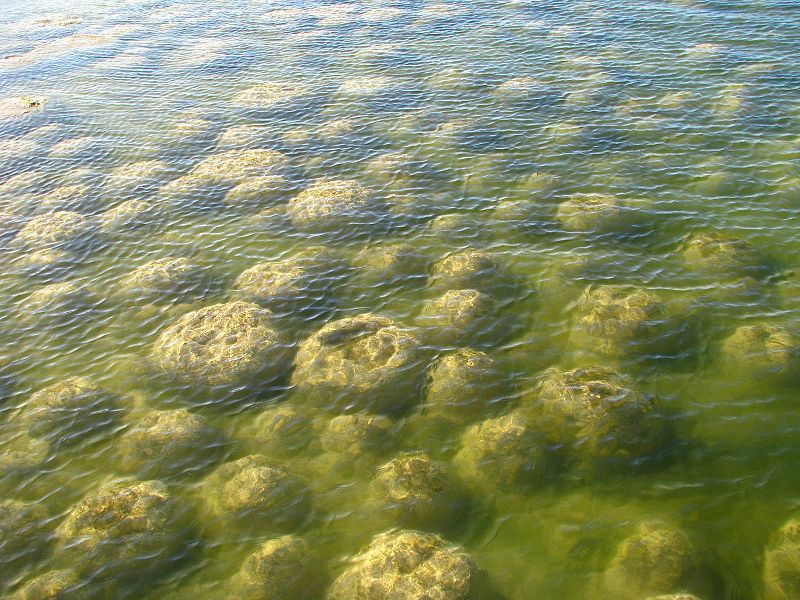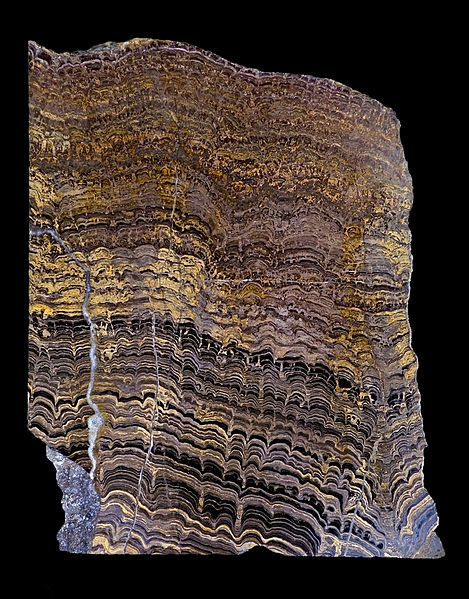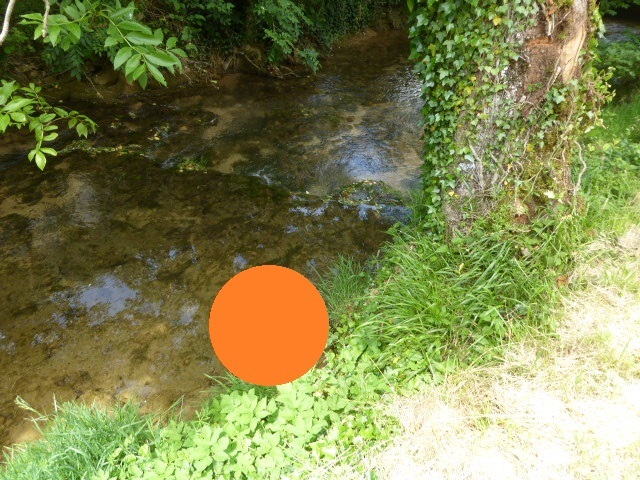
 La reculée de Baume-les Messieurs est la plus belle et la plus caractéristique des reculées du Jura.
La reculée de Baume-les Messieurs est la plus belle et la plus caractéristique des reculées du Jura.
La Reculée
Une reculée est une forme morphologique désignant une échancrure prononcée dans un plateau de couches calcaires tabulaires horizontales constituant un type de vallées fréquentes dans le Jura, en Bourgogne, dans les Causses...
La reculée s'achève en amont par un cirque entouré de falaises verticales au pied desquelles prend le plus souvent naissance une rivière, qui est souvent l'exutoire d'un système hydrologique karstique souterrain circulant au travers de cavités interconnectées.
Pour en savoir plus sur sa formation, on ne peut que recommander de pousser la ballade jusqu'à GC4G906.
Les Stromatolithes

Exemple de stromatolithes actuels (Shark Bay, Australie)
Ce sont des constructions sédimentaires, carbonatées, formées d'une superposition de lamines millimétriques précipitées par des processus biochimiques. Les lamines sont le résultat de l'activité biochimique de micro-organismes photosynthétiques, principalement des cyanobactéries.
Pour parler de stromatolithes sensu stricto, il doit s'agir de structures qui se développent à partir d'un point formant donc des colonnes, des dômes, des boules, des cônes…
On voit que les stromatolithes sensu stricto ne sont qu'un cas particulier de toutes sortes de concrétions laminaires liées à l'activité biologique d'êtres vivants allant des cyanobactéries aux eucaryotes (algues vertes), Les limites de la définition sont donc floues, puisque par exemple des concrétions en boules initialement disjointes peuvent se rejoindre au cours de leur croissance, se "coller" et faire ensuite un encroûtement continu.

Stromatolithe vu en coupe, montrant l'empilement de lamines
La formation d'une lamine vient le plus souvent du piégeage "mécanique" d'un micro-précipité de carbonate, micro-précipité en suspension engendré par le dégazage physique et surtout micro-précipité engendré par la photosynthèse. Le mucilage produit par le voile de micro-organismes croissant sur la lamine précédente va en effet piéger et "agglomérer" toutes les micros-particules présentes, celles amenées par le courant (ici peu rapide) et surtout celles crées in situ au voisinage immédiat des micro-organismes photosynthétiques. Chaque modification ou arrêt notable de la production des carbonates va se traduire par une modification de la structure du dépôt, ce qui donne cette structure laminée.
Devenues très rares, les structures récifales actuelles semblent tout à fait similaires aux stromatolithes formés il y a plus de 3 milliards d'années.
Voilà ce que l'on peut lire dans de doctes ouvrages.
Quelle ne fut pas notre surprise d'y apprendre que parmi la courte liste des endroits dans le monde où se forment aujourd'hui des stromatolithes figurait le Dard dans la reculée de Baume les Messieurs !
L'Earthcache


Pour loguer cette EarthCache, rendez-vous aux coordonnées, et répondez aux questions suivantes.
1 ► Expliquez dans vos propres mots comment se forme un stromatolithe.
2 ► Que pouvez-vous observer sous le masque orange ? Est-il symétrique ? Pourquoi d'après vous ?
3 ► Joignez à votre log une photographie permettant ou non de vous identifier (visage, GPS, pseudo, etc.) sur le site... mais sans montrer des éléments qui pourraient compromettre la résolution de la cache. Rien d'obligatoire mais très apprécié : Soyez créatif !
Rappels concernant les « EarthCaches » :
Il n’y a pas de contenant à rechercher aux coordonnées, ni de carnet à signer sur place. Il suffit de se rendre sur les lieux, de répondre aux questions ci-dessus, et de nous envoyer vos propositions de réponse soit via notre profil, soit la messagerie geocaching.com (Message Center).
Vous pouvez loguer un « Found it » sans attendre notre confirmation. Nous vous contacterons en cas de problème ou pour fournir d’éventuelles précisions.
Les « Found it » enregistrés sans envoi de réponses seront supprimés.
Bon Géocaching !

The Reculée
A reculée is a morphological form designating a pronounced indentation in a plateau of horizontal tabular limestone layers constituting a type of valley frequent in the Jura, in Burgundy, in the Causses...
The reculée ends upstream in a cirque surrounded by vertical cliffs, at the foot of which a river usually originates, often as the outlet of an underground karstic hydrological system flowing through interconnected cavities.
To find out more about its formation, we can only recommend that you take the walk to GC4G906.
Stromatoliths

Example of present-day stromatolites (Shark Bay, Australia)
These are sedimentary, carbonate constructions formed by a superposition of millimetric laminae precipitated by biochemical processes. The laminae are the result of the biochemical activity of photosynthetic micro-organisms, mainly cyanobacteria.
To speak of stromatolites sensu stricto, they must be structures that develop from a point forming columns, domes, balls, cones, etc.
We can see that stromatolites sensu stricto are only a particular case of all sorts of laminar concretions linked to the biological activity of living beings ranging from cyanobacteria to eukaryotes (green algae). The limits of the definition are therefore blurred, since, for example, initially disjointed ball-shaped concretions can join together during their growth, "stick" together and then form a continuous crust.

Stromatolithe vu en coupe, montrant l'emilement de lamines
The formation of a lamina most often comes from the "mechanical" trapping of a carbonate micro-precipitate, a micro-precipitate in suspension generated by physical degassing and above all a micro-precipitate generated by photosynthesis. The mucilage produced by the veil of micro-organisms growing on the previous lamina will indeed trap and "agglomerate" all the micro-particles present, those brought by the current (which is not very fast in this case) and especially those created in situ in the immediate vicinity of the photosynthetic micro-organisms. Each modification or notable stop in the production of carbonates will result in a modification of the structure of the deposit, which gives this laminated structure.
Today's reef structures have become very rare and appear to be quite similar to stromatolites formed over 3 billion years ago.
This is what we read in the academic literature.
We were surprised to learn that among the short list of places in the world where stromatolites are formed today was the Dard in the Baume les Messieurs retreat!
The Earthcache


To log this EarthCache, go to the coordinates located close to the church, and answer the following questions.
1 ► Explain in your own words how a stromatolite is formed.
2 ► What can you observe under the orange mask? Is it symmetrical? Why is it so?
3 ► Join to your log a photo that identifies you (face, GPS, nickname, etc.) on the site... but without showing elements that may compromise the resolution of the cache. Be creative!
Reminders about the “EarthCaches”:
There is no container to look for nor a logbook to sign. Just go to the location, answer the questions above, and send us your proposals of answers either via our profile or Message Center.
You can log “Found it” without waiting for our validation. We will contact you in case of problems or to provide any clarification.
“Found it” logs saved without sending answers will be deleted.
Happy caching!